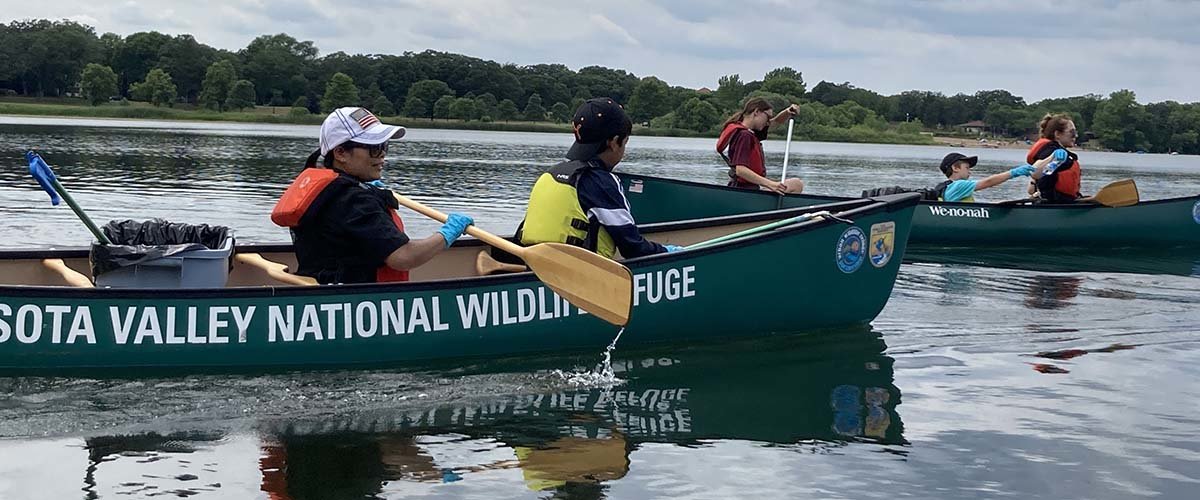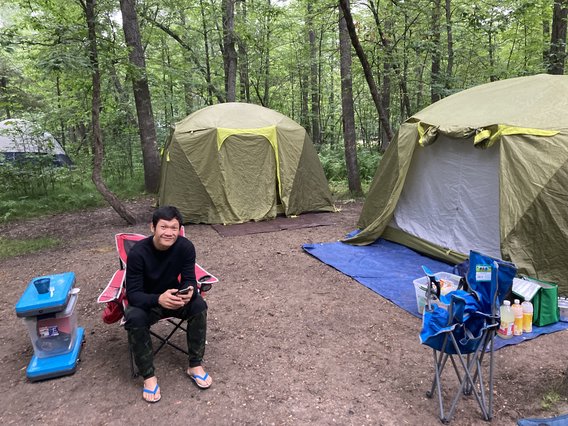
Nurturing nature
CFANS graduate student Lucas Rapisarda leads Nature for New Minnesotans, offers immigrants hands-on nature learning experiences in tandem with adult English language courses

KATHERINE STOCK, COMMUNICATIONS STUDIES, BA '24
From introducing participants to the trickling Mississippi River headwaters to helping them navigate with paddles during their first time in a canoe, Lucas Rapisarda understands the value of being connected to the natural world. As program director for the Nature for New Minnesotans (NFNM) organization, he encourages his students to build their own relationship with the environment.
NFNM educates adult English Language (EL) learners about nature in Minnesota for free, made possible by the Minnesota Environment and Natural Resources Trust Fund. Rapisarda, a PhD student in the Department of Fisheries, Wildlife and Conservation Biology (FWCB), took over the initiative for Britt Forsberg, an Extension educator at the University. Forsberg started NFNM alongside her friend Jenne Nelson who works in non-profit leadership, and her colleague Rob Blair, PhD, FWCB department head, to expand natural sciences education into more communities.

Because Rapisarda spent seven years as a science educator and an advocate for educational, racial, and social justice prior to his arrival at the University of Minnesota, this was the perfect opportunity for him to combine his passions and expand his experience. “I’m impressed by Lucas’s thoughtfulness and commitment to the project,” Forsberg said. “He’s brought in creative ideas and has really expanded the project beyond our initial idea. I couldn’t ask for anyone better to implement my ‘what if?’ pondering in real life.”
In NFNM, Rapisarda teaches students from Vietnam, Egypt, Guatemala, Ethiopia, and more, who range from younger than 30 to 70 years old and who come from a variety of different education levels. He feels encouraged by the participant diversity that NFNM has achieved, while also recognizing the program’s challenges. “This diversity of experiences, ages, and backgrounds has made creating a uniform curriculum that addresses the needs of all learners difficult,” he explained. “As a [kindergarten through 12th grade] teacher, I had very few EL students in my classroom, and K12 programs often [already] have adapted materials for these students.”
Rapisarda is starting from a nearly blank slate, as adult basic education in Minnesota does not have standards for science and provides limited materials. Furthermore, the act of working with other EL teachers and outdoor partners has posed a challenge because most, if not all, nature interpretation programs in Minnesota are designed for English speakers.
“EL educators also need training on natural history and how to engage their students in learning less common, more complex scientific vocabulary,” Rapisarda said. He plans to combat this challenge by designing workshops for EL educators and outdoor partners to develop content together.
There are also challenges outside of the program that immigrants and people of color disproportionately face compared to white peers that cause what’s called a nature gap. Rapisarda explained that some of these barriers include but are not limited to, transportation, a need for disposable income, fear of breaking the law due to unfamiliarity with local laws and customs, and even redlining, which has led to fewer greenspaces in communities of color.
To support students, Rapisarda works with others in NFNM to design lessons that incorporate natural history with a contextual understanding of science concepts that connect students to the natural, social, and economic world. For example, in a lesson about learning to canoe, NFNM educators describe what canoes are and discuss their history among the Indigenous peoples of Minnesota. “This opens up discussions on the history of the land of Minnesota and places the act of canoeing in context within the state,” Rapisarda said. “In addition to discussing the history of canoes, we explore water, water quality, and water monitoring – connecting one’s use of water for transportation and one’s responsibility to protect water,” he explained. “Lastly, we show students how they can rent canoes and kayaks online or over the phone, creating opportunities for them to practice conversational English and their computer skills.”

While working with such a diverse group, Rapisarda has also learned more about different perspectives of nature himself, such as Indigenous theory, which in part means being a steward of the land to keep it whole for the next generation. Rapisarda retold his students’ stories about “running, under cover of darkness, through natural spaces to reach safe havens…climbing trees, chasing monkeys, and learning to hunt from a family member.” Because of them, he has a clearer understanding of why the definition and meaning of nature should expand beyond a single, narrow view. It reinforces the point of why programs like NFNM are important. “It allows students to share their new-found knowledge with their families and develop a stronger connection to both the activity and the place,” he said.
Rapisarda has three goals for NFNM that he hopes to accomplish five years from now. First, he hopes to develop a longer list of modules—approved and tested by EL educators—covering foraging and native plants, winter activities in Minnesota, the Mississippi River watershed, volunteer environmental monitoring and community science, and more. He also plans to expand NFNM’s network of outdoor opportunities with organizations that already support specific immigrant communities, such as Hmong Outdoors. This way, students can participate in hands-on activities that they may not be able to otherwise. Lastly, he wishes to organize workshops for EL educators and outdoor partners to collaborate on and improve lessons for students. “My goal is not to get more people fishing, but to show students that they can engage in nature however they choose, and give them the confidence to do so,” Rapisarda said.
Funding for this project was provided by the Minnesota Environment and Natural Resources Trust Fund as recommended by the Legislative-Citizen Commission on Minnesota Resources (LCCMR). The Trust Fund is a permanent fund constitutionally established by the citizens of Minnesota to assist in the protection, conservation, preservation, and enhancement of the state’s air, water, land, fish, wildlife, and other natural resources. Currently 40% of net Minnesota State Lottery proceeds are dedicated to growing the Trust Fund and ensuring future benefits for Minnesota’s environment and natural resources.





